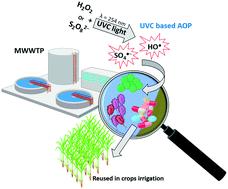当前位置:
X-MOL 学术
›
Environ. Sci.: Water Res. Technol.
›
论文详情
Our official English website, www.x-mol.net, welcomes your
feedback! (Note: you will need to create a separate account there.)
UVC-based advanced oxidation processes for simultaneous removal of microcontaminants and pathogens from simulated municipal wastewater at pilot plant scale
Environmental Science: Water Research & Technology ( IF 3.5 ) Pub Date : 2020-06-19 , DOI: 10.1039/d0ew00279h Isaac Sánchez-Montes 1, 2, 3, 4 , Irene Salmerón García 5, 6, 7 , Gracia Rivas Ibañez 5, 6, 7 , José Mario Aquino 1, 2, 3, 4 , María Inmaculada Polo-López 5, 6, 7 , Sixto Malato 5, 6, 7 , Isabel Oller 5, 6, 7
Environmental Science: Water Research & Technology ( IF 3.5 ) Pub Date : 2020-06-19 , DOI: 10.1039/d0ew00279h Isaac Sánchez-Montes 1, 2, 3, 4 , Irene Salmerón García 5, 6, 7 , Gracia Rivas Ibañez 5, 6, 7 , José Mario Aquino 1, 2, 3, 4 , María Inmaculada Polo-López 5, 6, 7 , Sixto Malato 5, 6, 7 , Isabel Oller 5, 6, 7
Affiliation

|
The challenge of providing good-quality reclaimed water free from contaminants of emerging concern, even at small concentrations, i.e., microcontaminants (MCs), and pathogens is one of the main hot topics worldwide. UVC-based advanced oxidation processes, using in situ production of strong oxidizing radicals, such as HO˙ and SO4˙−, have shown high oxidation rates for MCs; however, few studies have focused on the simultaneous removal of MCs and pathogens, like bacteria. Thus, the aim of this work was to assess the oxidation of six MCs, acetaminophen (ACT), caffeine, (CAF), carbamazepine (CBZ), trimethoprim (TMP), sulfamethoxazole (SMX), and diclofenac (DCF), in the presence of Escherichia coli, Enterococcus faecalis, and Salmonella enteritidis in a simulated effluent from a municipal wastewater treatment plant by the application of UVC/H2O2 and UVC/S2O82− processes at pilot plant scale. The concentration of MCs and bacteria was monitored along the oxidation processes as well as their regrowth after 24, 48, and 144 h. UVC-based processes were compared in terms of the required treatment time to remove at least 80% of the sum of MCs, regrowth assessment, and energy consumption. Despite the UVC/H2O2 and UVC/S2O82− processes showing similar results, even after using distinct molar concentrations, the UVC/H2O2 process did not exhibit bacterial regrowth under dark conditions. A simple model has also been proposed in this work with the main objective of calculating the minimum concentration of oxidants as a function of the radiation absorption at 254 nm in a given photo-reactor setup.
中文翻译:

基于UVC的高级氧化工艺,可在中试规模的同时从模拟市政废水中去除微量污染物和病原体
提供优质的挑战回收来自新兴关心的污染物的游离水,即使在低浓度,即,微污染物(MCS)和致病菌的主要热点之一全世界。UVC基于高级氧化法,使用原位生产强氧化性基团,如Ho和SO的4 ˙ - ,都表现出高的氧化率的MC; 但是,很少有研究集中于同时去除MC和病原体,例如细菌。因此,这项工作的目的是评估六种MCs中对乙酰氨基酚(ACT),咖啡因,(CAF),卡马西平(CBZ),甲氧苄啶(TMP),磺胺甲恶唑(SMX)和双氯芬酸(DCF)的氧化。大肠杆菌的存在,通过在试点工厂规模应用UVC / H 2 O 2和UVC / S 2 O 8 2-过程对市政污水处理厂的模拟废水中的粪肠球菌和肠炎沙门氏菌进行处理。在24、48和144小时后,沿着氧化过程以及它们的再生长监测MC和细菌的浓度。比较了基于UVC的工艺所需的处理时间,以去除至少80%的总有机碳,再生评估和能耗。尽管有UVC / H 2 O 2和UVC / S 2 O 8 2-即使在使用不同的摩尔浓度后,UVC / H 2 O 2工艺也显示出相似的结果,在黑暗条件下也不会出现细菌再生。在这项工作中,还提出了一个简单的模型,其主要目的是在给定的光反应器设置中,根据254 nm处的辐射吸收来计算氧化剂的最小浓度。
更新日期:2020-08-27
中文翻译:

基于UVC的高级氧化工艺,可在中试规模的同时从模拟市政废水中去除微量污染物和病原体
提供优质的挑战回收来自新兴关心的污染物的游离水,即使在低浓度,即,微污染物(MCS)和致病菌的主要热点之一全世界。UVC基于高级氧化法,使用原位生产强氧化性基团,如Ho和SO的4 ˙ - ,都表现出高的氧化率的MC; 但是,很少有研究集中于同时去除MC和病原体,例如细菌。因此,这项工作的目的是评估六种MCs中对乙酰氨基酚(ACT),咖啡因,(CAF),卡马西平(CBZ),甲氧苄啶(TMP),磺胺甲恶唑(SMX)和双氯芬酸(DCF)的氧化。大肠杆菌的存在,通过在试点工厂规模应用UVC / H 2 O 2和UVC / S 2 O 8 2-过程对市政污水处理厂的模拟废水中的粪肠球菌和肠炎沙门氏菌进行处理。在24、48和144小时后,沿着氧化过程以及它们的再生长监测MC和细菌的浓度。比较了基于UVC的工艺所需的处理时间,以去除至少80%的总有机碳,再生评估和能耗。尽管有UVC / H 2 O 2和UVC / S 2 O 8 2-即使在使用不同的摩尔浓度后,UVC / H 2 O 2工艺也显示出相似的结果,在黑暗条件下也不会出现细菌再生。在这项工作中,还提出了一个简单的模型,其主要目的是在给定的光反应器设置中,根据254 nm处的辐射吸收来计算氧化剂的最小浓度。









































 京公网安备 11010802027423号
京公网安备 11010802027423号